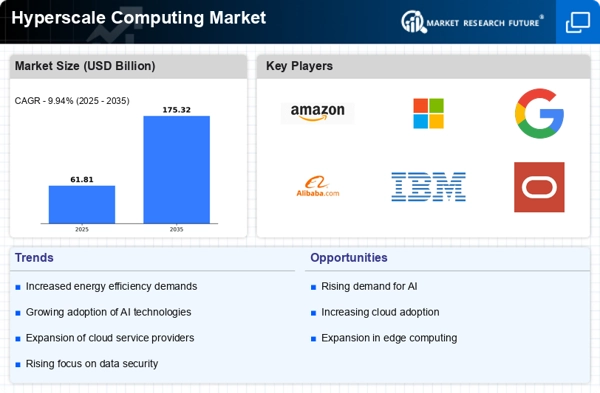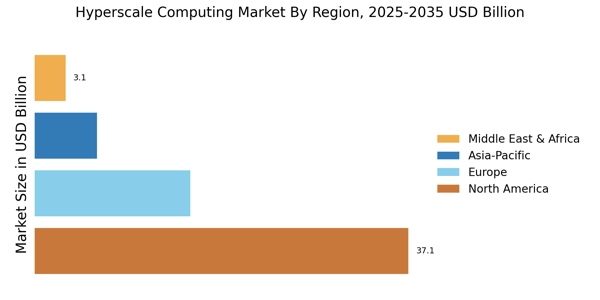The Hyperscale Computing Market is characterized by intense competition and rapid technological advancements, driven by the increasing demand for cloud services, data analytics, and artificial intelligence. Major players such as Amazon (US), Microsoft (US), and Alibaba (CN) are at the forefront, each adopting distinct strategies to enhance their market positioning. Amazon (US) focuses on expanding its AWS offerings, emphasizing innovation in cloud infrastructure, while Microsoft (US) leverages its Azure platform to integrate AI capabilities, thereby enhancing user experience. Alibaba (CN) is strategically investing in data centers across Asia to bolster its cloud services, indicating a regional expansion focus. Collectively, these strategies contribute to a dynamic competitive environment, where agility and technological prowess are paramount.
Key business tactics within the hyperscale computing sector include localizing manufacturing and optimizing supply chains to enhance operational efficiency. The market structure appears moderately fragmented, with a few dominant players exerting considerable influence. This fragmentation allows for niche players to emerge, yet the collective strength of the key players shapes market dynamics significantly, as they continuously innovate and adapt to changing consumer demands.
In August 2025, Amazon (US) announced the launch of its new AI-driven cloud service, which aims to enhance data processing capabilities for enterprises. This strategic move not only reinforces Amazon's commitment to innovation but also positions it to capture a larger share of the growing AI market. By integrating advanced machine learning algorithms into its cloud offerings, Amazon (US) is likely to attract businesses seeking to leverage AI for operational efficiency, thereby solidifying its competitive edge.
In September 2025, Microsoft (US) unveiled a partnership with a leading telecommunications provider to enhance its Azure cloud services. This collaboration is expected to improve connectivity and reduce latency for users, particularly in underserved regions. By focusing on partnerships that enhance service delivery, Microsoft (US) demonstrates a strategic approach to expanding its market reach and improving customer satisfaction, which could lead to increased adoption of its cloud solutions.
In July 2025, Alibaba (CN) launched a new initiative aimed at promoting sustainable cloud computing practices. This initiative includes investments in renewable energy sources for its data centers, reflecting a growing trend towards sustainability in the hyperscale computing sector. By prioritizing environmental responsibility, Alibaba (CN) not only addresses regulatory pressures but also appeals to a consumer base increasingly concerned with sustainability, potentially enhancing its brand reputation and market position.
As of October 2025, the hyperscale computing market is witnessing trends such as digitalization, sustainability, and AI integration, which are reshaping competitive dynamics. Strategic alliances are becoming increasingly vital, as companies seek to leverage complementary strengths to enhance their offerings. Looking ahead, competitive differentiation is likely to evolve from traditional price-based competition to a focus on innovation, technological advancements, and supply chain reliability. This shift underscores the importance of agility and responsiveness in a rapidly changing market landscape.


















Leave a Comment